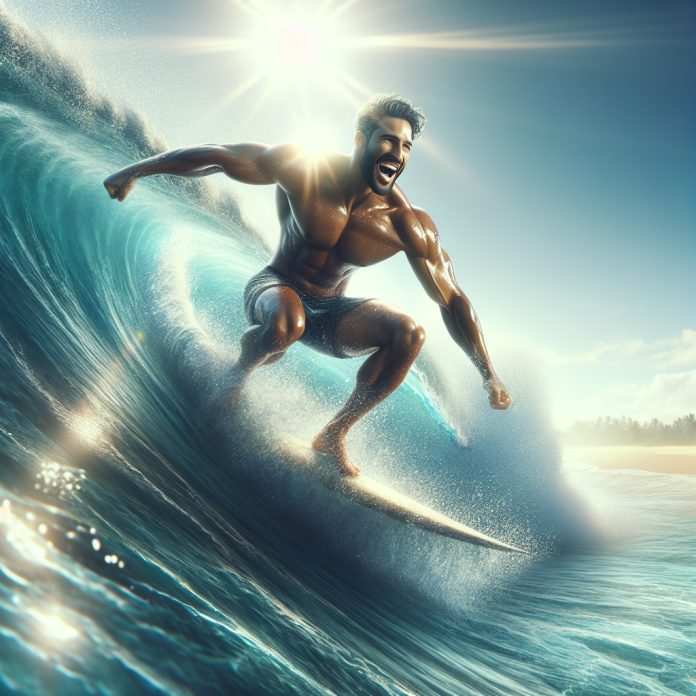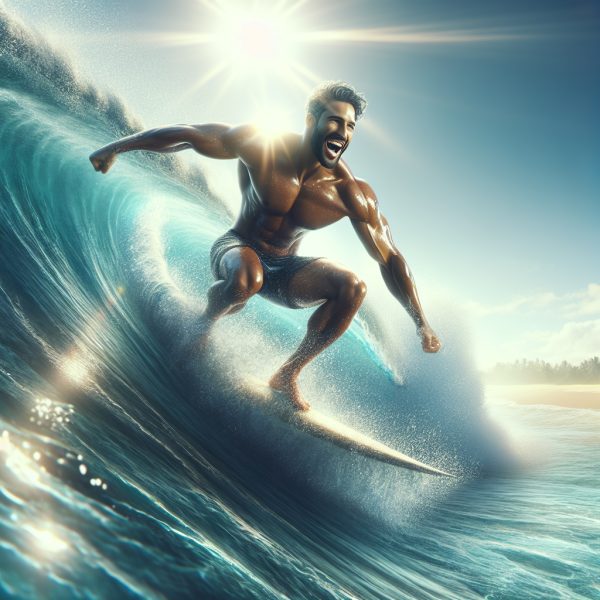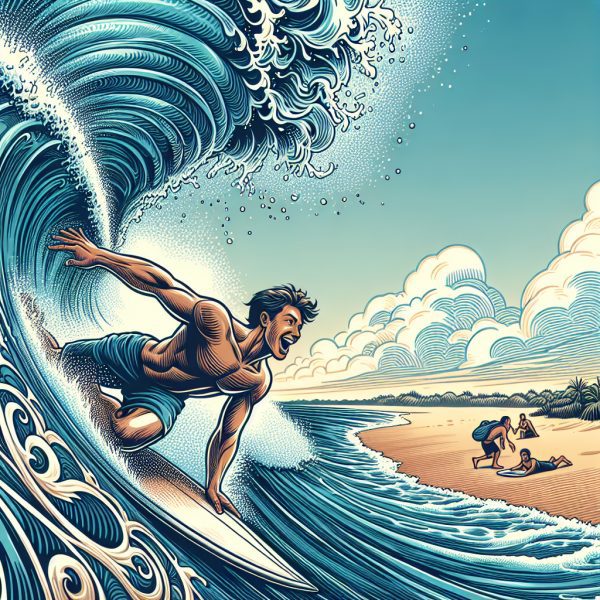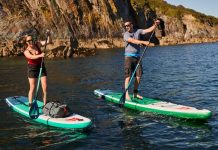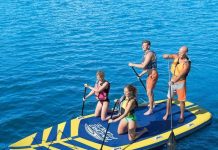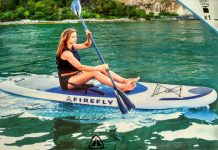Imagine the exhilarating rush of riding a wave, feeling the power of the ocean propelling you forward. Now, picture yourself doing it without a surfboard. That’s right, just you and your body, gliding effortlessly through the water. This is the art of bodysurfing, a thrilling water sport that allows you to become one with the waves. In this article, we’ll take you on a journey into the world of bodysurfing, exploring the techniques, tips, and adrenaline-pumping experiences that come with catching a wave with nothing but your own body. Get ready to feel the rush like never before!
Equipment
Swim Fins
Swim fins are an essential piece of equipment for bodysurfing. They are designed to enhance your propulsion through the water and increase speed, allowing you to catch and ride waves more effectively. When choosing swim fins, it’s important to find a pair that fits snugly but comfortably on your feet. Look for fins made from durable materials that provide flexibility and optimum maneuverability in the water.
Handboards
Handboards, also known as handplanes, are small foam or fiberglass boards that are held in the hand while bodysurfing. They provide additional lift and control, allowing you to glide across the wave’s surface and perform tricks and maneuvers. Handboards come in various shapes and sizes, so it’s essential to choose one that suits your skill level and wave conditions.
Wetsuit or Rashguard
Wearing a wetsuit or rashguard is crucial for protecting your skin from the sun, waves, and potential scrapes or cuts. These garments also help insulate your body and keep you warm in colder water temperatures. Depending on the climate and water conditions, choose a wetsuit or rashguard that provides adequate coverage and insulation while allowing for freedom of movement.
Tethers and Leashes
Tethers and leashes are important safety accessories when bodysurfing. They help secure your equipment to your body and prevent it from getting lost or swept away by the waves. Attach a tether or leash to your swim fins and handboard to ensure they stay within reach even if you fall off or get caught in powerful currents.
Choosing the Right Wave
Reading Waves
Reading waves is a skill that every bodysurfer should develop. Understanding how waves break and form can help you determine the best position to catch and ride them effectively. Look for waves that have a clean face with a consistent shape and size. Avoid waves that are too close to shore or breaking too aggressively, as they can be dangerous and difficult to ride.
Wave Size
The size of the waves plays a significant role in bodysurfing. It’s essential to choose waves that are suitable for your skill level and comfort. As a beginner, it’s best to start with smaller waves that are easier to manage and ride. As you gain experience and confidence, gradually challenge yourself by attempting larger and more powerful waves.
Wave Shape
Different wave shapes offer diverse opportunities for bodysurfing. Waves can be steep and hollow or long and rolling. Hollow waves, also known as barrels, provide the opportunity for tube rides and more advanced maneuvers. Rolling waves, on the other hand, are ideal for longer rides and practicing trimming and adjusting techniques.
Wave Speed
The speed of a wave affects the difficulty and intensity of bodysurfing. Faster waves require quick reflexes and stronger paddling to catch and ride. Slower waves are more forgiving and allow for a slower, more relaxed approach. Pay attention to the wave speed and adjust your technique and positioning accordingly.
Techniques
Body Positioning
Proper body positioning is crucial for successful bodysurfing. When paddling, keep your body flat and streamlined on the surface of the water. As you catch the wave, transition into a prone position with your arms extended in front of you. Maintain a balanced and stable body position, using your core muscles to control your movements and stay aligned with the wave.
Timing and Paddling
Timing is everything in bodysurfing. To catch a wave, paddle with strong, powerful strokes just ahead of the wave’s breaking point. The goal is to match the wave’s speed and lift, allowing it to carry you forward. Practice your paddling technique to develop strength and efficiency, as it directly impacts your ability to catch and ride waves.
Taking Off
Taking off refers to the moment when you transition from paddling to riding the wave. As the wave approaches, use your arms and core muscles to propel yourself forward and onto the wave’s face. Maintain a controlled and balanced position, ready to adjust your body and movements as needed to maintain stability and control.
Riding the Wave
Once you’ve successfully taken off, focus on riding the wave with grace and control. Keep your body aligned with the wave’s direction, adjusting your weight distribution and movements to maintain balance and stability. As you gain experience, experiment with different maneuvers and techniques, such as trimming and adjusting, to maximize your ride and overall enjoyment.
Trimming and Adjustments
Trimming and making adjustments while riding the wave is a skill that separates the skilled bodysurfers from the beginners. Trimming refers to the act of positioning your body in a way that allows you to ride the wave’s face and generate speed. Adjustments involve shifting your weight and movements to maintain balance and control as the wave changes shape and speed. With practice, you can master these techniques and enjoy longer and more exciting rides.
Safety
Swimming Ability
Having strong swimming skills is crucial for bodysurfing safely. Before venturing into the ocean, make sure you are comfortable swimming in various conditions and have the stamina to handle potentially demanding situations. Consider taking swimming lessons or practicing in controlled environments to improve your swimming ability and confidence.
Rip Currents and Undertows
Rip currents and undertows are powerful currents that can quickly sweep you away from shore. It’s essential to be aware of these hazards and know how to identify and navigate them safely. If caught in a rip current, swim parallel to the shore until you escape its pull. Avoid swimming alone in unfamiliar areas and always pay attention to any warnings or advisories from lifeguards.
Waves Breaking on Shallow Sandbars
Waves breaking on shallow sandbars can be dangerous, especially for inexperienced bodysurfers. These waves can create powerful shore breaks that can cause injuries if mishandled. Make sure to observe the wave action and choose areas with deeper water where waves break more gently. Avoid diving headfirst into unfamiliar areas and always be cautious when bodysurfing near sandbars.
Injuries
While bodysurfing is generally a safe activity, it’s not without its risks. Injuries such as cuts, scrapes, bruises, and even fractures can occur when navigating through powerful waves. Always be aware of your surroundings, avoid reckless behavior, and wear appropriate protective gear like rashguards and wetsuits to minimize the risk of injury. If an injury does occur, seek immediate medical attention and follow proper wound care protocols.
Etiquette
Respecting the Line-up
Respecting the line-up is an essential part of bodysurfing etiquette. The line-up refers to the area where surfers and bodysurfers wait for their turn to catch a wave. It’s important to wait your turn and avoid dropping in or taking off on a wave that another person is already riding. Be patient, observe the order, and give fellow bodysurfers the courtesy of having their own waves.
Right of Way
Understanding the right of way rules is essential for maintaining a safe and enjoyable bodysurfing experience. Typically, the person closest to the breaking wave has the right of way and should be given priority to catch and ride it. Avoid snaking or cutting off other bodysurfers, as it can lead to collisions and frustration. Respect the established order and communicate with other surfers and bodysurfers to ensure everyone can enjoy their time in the water.
Sharing Waves
Sharing waves is a fundamental aspect of bodysurfing etiquette. After catching a wave, be aware of other bodysurfers around you and make space for them to also catch the wave if possible. When riding a wave, try to maintain a straight and predictable line, avoiding sudden changes in direction that could potentially interfere with others. Remember, sharing waves ensures a harmonious and inclusive bodysurfing experience for everyone.
Communication
Clear and effective communication is key when bodysurfing in crowded line-ups. Use hand signals or verbal cues to indicate your intentions and warn others of potential hazards or changes in direction. Politely communicate if you have the right of way or if you’re yielding to another surfer. Good communication helps prevent misunderstandings and keeps everyone safe and aware of their surroundings.
Environmental Responsibility
As bodysurfers, it’s our responsibility to protect and respect the ocean environment. Avoid leaving any trash or litter on the beach or in the water. Be mindful of marine life and avoid disturbing or harming any creatures you encounter. Consider participating in beach clean-up initiatives or supporting conservation organizations that work to preserve our oceans and their ecosystems. By practicing environmental responsibility, we can ensure that future generations can also enjoy the beauty and wonders of bodysurfing.
Common Challenges
Getting Tumbled by Waves
Getting tumbled by waves is an inevitable challenge in bodysurfing. When caught by a powerful wave, it can churn you underwater, disorienting and occasionally causing anxiety or panic. Stay calm, cover your head with your arms, and keep your body relaxed. Wait for the wave’s motion to subside before resurfacing and regaining your bearings.
Fighting the Current
Strong currents can make it challenging to stay in position or return to the lineup. Instead of trying to fight against the current, conserve energy by swimming parallel to the shore until you find a path back to your desired location. If the current proves unmanageable, consider moving to a different area with weaker currents or seeking assistance from lifeguards if necessary.
Getting Caught Inside
Being caught inside refers to finding yourself in the impact zone where waves are breaking forcefully. It can be a challenging and potentially dangerous situation. The key is to remain calm and make your way towards the surface as soon as possible. If necessary, dive deep to avoid the full force of the breaking wave and slowly surface once the wave has passed. Always be vigilant and aware of your surroundings to minimize the risk of getting caught inside.
Staying in the Wave
One of the challenges of bodysurfing is maintaining your position within the wave. Waves can sometimes close out, meaning they break all at once, leaving no rideable face. To stay within the wave, adjust your body position and movements, using your arms and core muscles to maintain stability and balance. With practice, you’ll learn to read the wave’s behavior and make the necessary adjustments to stay in the sweet spot for a longer and more enjoyable ride.
Advanced Moves
Bottom Turns
Bottom turns are a fundamental maneuver in bodysurfing that allows you to change direction and generate speed. To execute a bottom turn, lean into the wave and shift your body weight to dig your shoulder into the water. This action redirects your momentum and propels you back towards the wave’s face, setting you up for more advanced maneuvers or longer rides.
Cutbacks
Cutbacks are an impressive and stylish move that involve redirecting your momentum to change direction sharply. As you approach the wave’s top or lip, shift your body weight and extend your arm to initiate the cutback. Dig your hand or forearm into the water while tilting your body in the desired direction. This technique generates enough force to redirect your path and maintain control while navigating the wave.
Tube Rides
Tube rides, also known as getting barreled, are the holy grail of bodysurfing. Riding inside the hollow part of a breaking wave is an exhilarating experience. To successfully ride in the tube, position yourself just ahead of the wave’s breaking point, tuck your body, and use your arms and legs to maintain balance as the wave barrels over you. Tube rides require precise timing and skill, but the reward of being fully enclosed by the wave is well worth the effort.
360 Spins
360 spins are a fun and flashy maneuver that adds flair to your bodysurfing. To execute a 360 spin, shift your body weight in the desired direction while keeping your body flat and aligned with the wave’s face. Use your arms and core muscles to generate rotational force and maintain stability as you complete the spin. Practice this move in smaller waves before attempting in larger, more powerful surf.
Tricks and Style
Hand Drag
Hand dragging is a stylish move that involves lightly dragging your hand or fingers along the wave’s surface as you ride. This move not only adds flair to your bodysurfing but also helps with balance and control. Experiment with different hand positions and movements to find the right combination for smooth and aesthetically pleasing hand drags.
Head Dip
A head dip is a classic bodysurfing move where you submerge your head briefly underwater as you ride a wave. This maneuver adds a touch of drama and can heighten the sensation of speed and power. As you gain experience and confidence, try incorporating head dips into your rides to enhance the visual impact and overall style of your bodysurfing.
Swim Dolphin-Style
Swimming dolphin-style is a graceful and efficient technique often used by experienced bodysurfers. Mimicking the movement of dolphins, this technique involves undulating your body and kicking your legs in a rhythmic manner to gain speed and propulsion. With practice, you can harness the power of your legs and core muscles to glide effortlessly through the water, adding an elegant touch to your bodysurfing.
Aerial Maneuvers
Advanced bodysurfers may attempt aerial maneuvers, such as launching themselves off of breaking waves for brief moments of aerial flight. These tricks require exceptional timing, skill, and experience, as they involve launching your body high in the air and safely landing back on the face of the wave. It’s essential to progress gradually and master the foundational skills of bodysurfing before attempting aerial maneuvers.
Best Spots for Bodysurfing
Pipe
Pipe, located on the North Shore of Oahu, Hawaii, is one of the most renowned and challenging waves for bodysurfing. It is famous for its powerful barrels and heavy shore break. Bodysurfing at Pipe requires expert level skills and experience due to the heavy and powerful nature of the waves. It’s a spot that should only be attempted by experienced and confident bodysurfers seeking an intense and adrenaline-pumping experience.
The Wedge
The Wedge, situated in Newport Beach, California, is a wave known for its powerful shore break and large swells. It’s a popular spot for bodysurfers seeking big waves and epic rides. The Wedge can provide exhilarating drops and intense tube rides, but it also poses significant challenges. It’s essential to approach this spot with caution, respect the power of the wave, and have the necessary skills and experience to handle its ferocity.
Sandy Beach
Sandy Beach, located on the eastern shore of Oahu, Hawaii, is a popular destination for bodysurfers of all skill levels. It offers a variety of wave shapes and sizes, making it suitable for beginners and experienced bodysurfers alike. Sandy Beach is renowned for its shore break and can provide excellent opportunities for barrel rides and advanced maneuvers. However, the powerful waves can also be unforgiving, so always exercise caution and be aware of your abilities and limitations.
Makapu’u
Makapu’u, also on the eastern shore of Oahu, Hawaii, is a beautiful spot for bodysurfing. It offers long, rolling waves with consistent breaks, making it ideal for honing your trimming and adjusting techniques. Makapu’u appeals to both beginners and more experienced bodysurfers due to its friendlier wave conditions. Enjoy the scenic views and ample wave opportunities, but always be respectful of the other surfers and bodysurfers sharing the lineup.
Famous Bodysurfers
Mark Cunningham
Mark Cunningham is widely regarded as one of the most influential and skilled bodysurfers in the world. Hailing from Oahu, Hawaii, he has dedicated his life to the sport and has won numerous bodysurfing competitions, including multiple world titles. Cunningham’s exceptional wave knowledge, impeccable style, and unwavering passion for bodysurfing have solidified his status as a legendary figure in the bodysurfing community.
Mike Stewart
Mike Stewart, known as “The Sultan of Stoke,” is a legendary bodysurfer hailing from Hawaii. With dozens of world titles under his belt, Stewart is one of the most successful and respected bodysurfers in history. He is admired for his innovative approach to the sport, pushing the boundaries with his unique tricks and maneuvers. Stewart’s contributions as a professional bodysurfer, entrepreneur, and ambassador for the sport have left an indelible mark on the bodysurfing community.
Sean Starky
Sean Starky, a California native, is recognized for his exceptional talent and skill in bodysurfing. Known for his fearless riding style and ability to tackle big waves, Starky has become a prominent figure in the bodysurfing world. From riding massive swells at The Wedge to pioneering innovative techniques, Starky continues to inspire and push the limits of what is possible in the realm of bodysurfing.
Tom Morey
Tom Morey is a legendary figure in the world of water sports, credited with inventing the boogie board, also known as a bodyboard. While Morey is primarily associated with bodyboarding, his love for the ocean and innovative spirit have contributed to the development and progression of bodysurfing as well. Morey’s enthusiasm for riding waves in all forms has had a profound impact on the sport and continues to influence and inspire bodysurfers worldwide.
In conclusion, bodysurfing is a thrilling and accessible way to ride the waves and connect with the ocean. With the right equipment, knowledge of wave reading, solid techniques, and a commitment to safety and etiquette, bodysurfing can provide endless hours of joy and excitement. Remember to always respect the ocean, fellow surfers, and the environment, and continue to push your limits while maintaining a sense of fun and camaraderie. So grab your swim fins, handboard, and wetsuit, and get ready to catch a wave and experience the exhilaration of bodysurfing!

